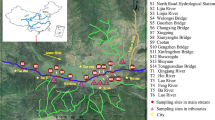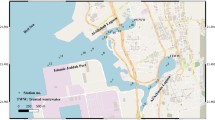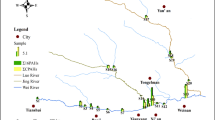Abstract
Polycyclic aromatic hydrocarbons (PAHs) with carcinogenic and mutagenic characteristics have been detected in many estuaries and bays around the world. To detect the contaminated level in typical estuaries in Haihe river basin, China, a comprehensive survey of 16 PAHs in surface sediment has been conducted and an ecological risk assessment has been taken. It showed that Haihe river estuary had the highest concentration, ranging from 92.91 to 15886.00 ng g−1. And Luan river estuary has the lowest polluted level, ranging from 39.55 to 328.10 ng g−1. PAHs in sediment were dominated by low and mid molecular weight PAHs in all the sampling sites. Most of the sampling sites in all sampling seasons indicated a rarely happened ecological risk of ΣPAHs, while the S6 in Haihe river estuary was in an occasionally anticipated risk. To illustrate the spatial distribution pattern of PAHs in surface sediment in Haihe river basin, the results were compared with previous research of the research team. Based on data of the comparison, it had been revealed that Haihe river had the most serious PAHs pollution, with an average concentration of 5884.86 ng g−1, and showed the highest contamination level in all four ecological units. The ΣPAHs concentration showed in a rank of reservoir > estuary > rural area > city.







Similar content being viewed by others
References
Baek SO, Field RA, Goldstone ME (1991) A review of atmospheric polycyclic aromatic hydrocarbons: sources, fate and behavior. Water Air Soil Pollut 60:279–300
Benner BA, Nelson PB, Stephen AW, George WM, Robert CL, Mervin FF (1990) Polycyclic aromatic hydrocarbon emissions from the combustion of crude oil on water. Environ Sci Technol 24:1418–1428
Burton GA (2002) Sediment quality criteria in use around the world. Limnology 3:65–75
Cao ZG, Liu JL, Luan Y (2010a) Pollution characteristics, risk assessment and source apportionment of polycyclic aromatic hydrocarbons (PAHs) in sediments and water of the Luan river, China. Acta Scientiae Circumstantiae 30(2):246–253 (in Chinese)
Cao ZG, Liu JL, Wang XM (2010b) Pollution characteristics, ecological risk assessment and sources of polycyclic aromatic hydrocarbons (PAHs) in surface water from the Zhangweinan river. Acta Scientiae Circumstantiae 30(2):254–260 (in Chinese)
Cao ZG, Liu JL, Luan Y, Li YL, Ma MY, Xu J, Han SL (2010c) Distribution and ecosystem risk assessment of polycyclic aromatic hydrocarbons in the Luan river, China. Ecotoxicology 19:827–837
Chen QY, Liu JL, Kin CH (2012) Development of a relative risk model for evaluating ecological risk of water environment in the Haihe river basin estuary area. Sci Total Environ 420:79–89
Cheng JO, Ko FC, Li JJ, Chen TH, Cheng YM, Lee CL (2012) Concentrations of polycyclic aromatic hydrocarbon in the surface sediments from inter-tidal areas of Kenting coast, Taiwan. Environ Monit Assess 184:3481–3490
Christensen ER, Irwan AL, Razak A, Rachdawong P, Karls JF (1997) Sources of polycyclic aromatic hydrocarbons in sediment of the Kinnickinnic river, Wisconsin. J Great Lakes Res 23:61–73
Fang MD, Hsieh PC, Ko FC, Baker JE, Lee CL (2007) Sources and distribution of polycyclic aromatic hydrocarbons in the sediments of Kaoping river and submarine canyon system, Taiwan. Mar Pollut Bull 54:1179–1189
Ginebreda A, Muñoz I, de Alda ML, Brix R, López-Doval J, Barceló D (2010). Environmental risk assessment of pharmaceuticals in rivers: relationships between hazard indexes and aquatic macroinvertebrate diversity indexes in the Llobregat river (NE Spain). Environ Int 36:153–162
Guan YF, Wang JZ, Ni HG, Zeng EY (2009) Organochlorine pesticides and polychlorinated biphenyls in riverine runoff of the Pearl river delta, China: an assessment of mass loading, input source and environmental fate. Environ Pollut 157:618–624
Halpern BS, Walbridge S, Selkoe KA et al (2008) A global map of human impact on marine ecosystems. Science 319:948–952
Harrison RM, Smith DJT, Luhana L (1996) Source apportionment of atmospheric polycyclic aromatic hydrocarbons collected from an urban location in Birmingham, UK. Environ Sci Technol 130:825–832
Hung CC, Gong GG, Ko FC, Chen HY, Hsu ML, Wu JM (2010) Relationships between persistent organic pollutants and carbonaceous materials in aquatic sediments of Taiwan. Mar Pollut Bull 60:1010–1017
Ionan M, Larraitz G, Manu S, Amaia O, Urtzi I, Miren PC (2013) Marine ecosystem health status assessment through integrative biomarker indices: a comparative study after the prestige oil spill “mussel watch”. Ecotoxicology 22:486–505
Jiang JJ, Lee CL, Fang MD, Liu JT (2009) Polycyclic aromatic hydrocarbons in coastal sediments of southwest Taiwan: an appraisal of diagnostic ratios in source recognition. Mar Pollut Bull 58:752–760
Li BH, Feng CH, Li X, Chen YX, Niu JF, Shen ZY (2012) Spatial distribution and source apportionment of PAHs in surficial sediments of the Yangtze estuary, China. Mar Pollut Bull 64:636–643
Liu JL, Chen QY, Li YL (2010) Ecological risk assessment of water environment for Luanhe river basin based on relative risk model. Ecotoxicology 19:1400–1415
Long ER, MacDonald DD (1998) Recommended uses of empirically derived sediment quality guidelines for marine and estuarine ecosystems. Hum Ecol Risk Assess 4:1019–1039
Long ER, MacDonald DD, Smith SL (1995) Incidence of adverse biological effects with in ranges of chemical concentration s in marine estuarine sediments. Environ Manage 19:81–97
Marina RG, Nicolai M, Paulo RB, Elina BC (2010) Assessment of polycyclic aromatic hydrocarbon influx and sediment contamination in an urbanized estuary. Environ Monit Assess 168:269–276
McCready S, Birch GF, Long ER, Spyrakis G, Greely CR (2006) Relationships between toxicity and concentrations of chemical contaminants in sediments from Sydney harbour, Australia, and vicinity. Environ Monit Assess 120:187–220
Miroslav M, Jan V, Luděk B, Miroslav C, Jiřì N (2001) Aryl hydrocarbon receptor-mediated activity of mutagenic polycyclic aromatic hydrocarbons determined using in vitro reporter gene assay. Mutat Res/Genet Toxicol Environ Mutagen 497:49–62
Mohamad I, Hwejeh I, Nasser M (2011) Distribution of polycyclic aromatic hydrocarbons (PAHs) in marine shore sediments of Alkaber Aljanuby river estuary. Fresenius Environ Bull 10:2624–2631
Ou DN, Liu M, Xu SY, Cheng SB, Hou LJ, Wang LL (2009) Distribution and ecological risk assessment of polycyclic aromatic hydrocarbons in overlying waters and surface sediments from the Yangtze estuarine and coastal areas. Environ Sci 30:3043–3049 (In Chinese)
Pekey H, Karakas D, Ayberk S, Tolun L, Bakoglu M (2004) Ecological risk assessment using trace elements from surface sediments of Izmit Bay (Northeastern Marmara Sea) Turkey. Mar Pollut Bull 489:46–953
Pozo K, Perra G, Menchi V, Urrutia R, Parra O, Rudolph A, Focardi S (2011) Levels and spatial distribution of polycyclic aromatic hydrocarbons (PAHs) in sediments from Lenga estuary, central Chile. Mar Pollut Bull 62:1572–1576
Sandro F, Marcell M, Karina SM (2011) Predicting bioaccumulation of PAHs in the trophic chain in the estuary region of Paranagua, Brazil. Environ Monit Assess 174:135–145
Sun FL, Wang YS, Sun CC, Peng YL, Deng C (2012) Effects of three different PAHs on nitrogen-fixing bacterial diversity in mangrove sediment. Ecotoxicology 21:1651–1660
Yan W, Chi J, Wang Z, Huang W, Zhang G (2009) Spatial and temporal distribution of polycyclic aromatic hydrocarbons (PAHs) in sediments from Daya Bay, South China. Environ Pollut 157:1823–1830
Zhang J (2008) Distributions and sources of hydrocarbonsin the Yellow river and its estuary. Ocean University of China (In Chinese), QingDao
Zhao ZY, Chu YL, GuJ D (2012) Distribution and sources of polycyclic aromatic hydrocarbons in sediments of the Mai Po inner deep Bay Ramsar site in Hong Kong. Ecotoxicology 21:1743–1752
Zhou JL, Hong HS, Zhang ZL, Maskaoui K, Chen WQ (2000) Multiphase distribution of organic micropollutants in Xiamen harbour, China. Water Res 34:2132–2150
Acknowledgments
The present study was supported by the National Water Pollution Control Important Specialized Science and Technology of China (No. 2012ZX07203-006) as well as the National Natural Science Foundation of China (No. 41271496). We want to thank Y. Yang, T. Yang, XG. You, Y. Li, and BB. Wang for field sampling.
Conflict of interest
The authors declare that they have no conflict of interests.
Author information
Authors and Affiliations
Corresponding author
Rights and permissions
About this article
Cite this article
Liu, J.L., Zhang, J., Liu, F. et al. Polycyclic aromatic hydrocarbons in surface sediment of typical estuaries and the spatial distribution in Haihe river basin. Ecotoxicology 23, 486–494 (2014). https://doi.org/10.1007/s10646-014-1233-7
Accepted:
Published:
Issue Date:
DOI: https://doi.org/10.1007/s10646-014-1233-7




